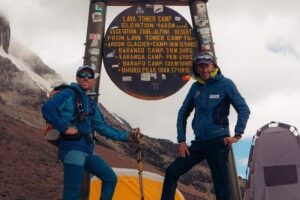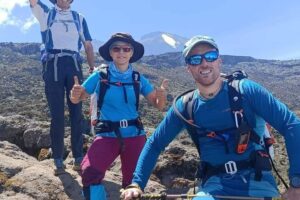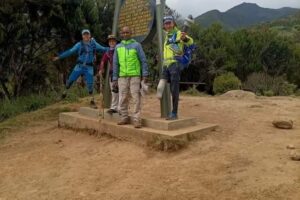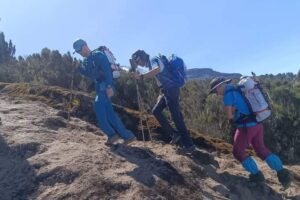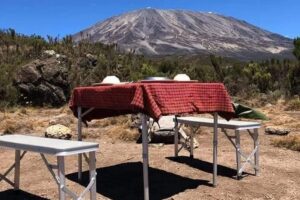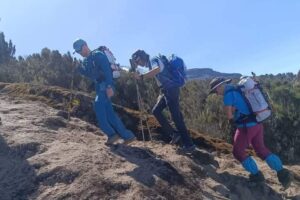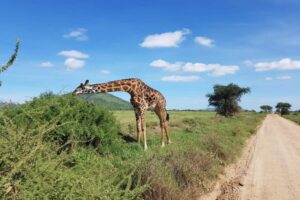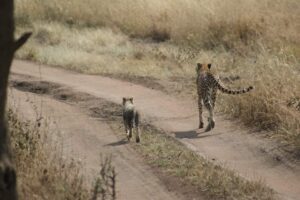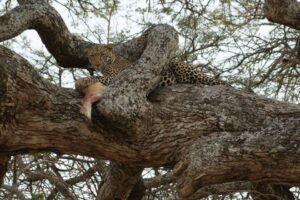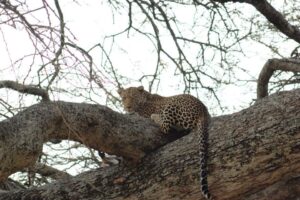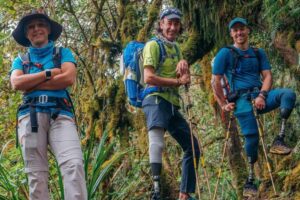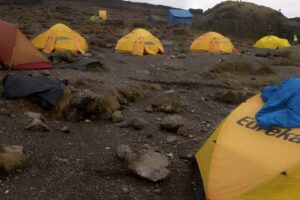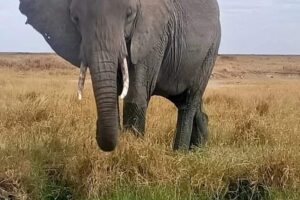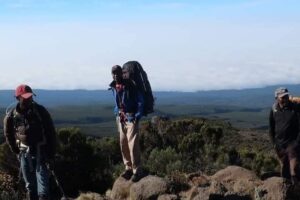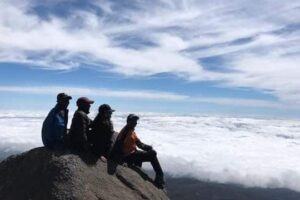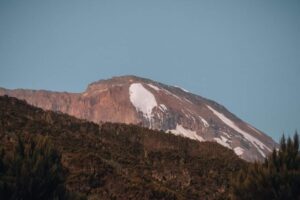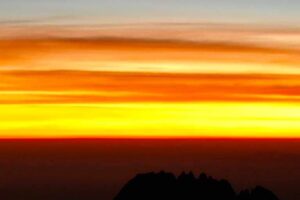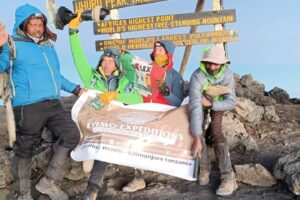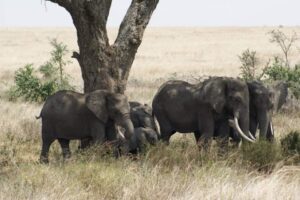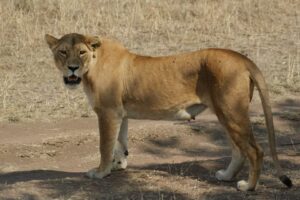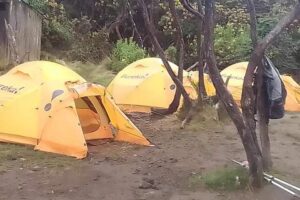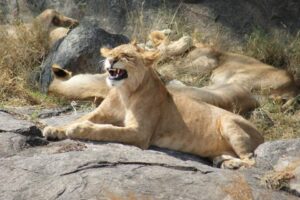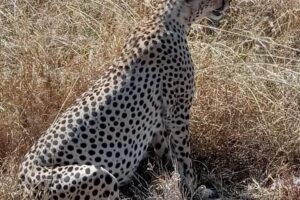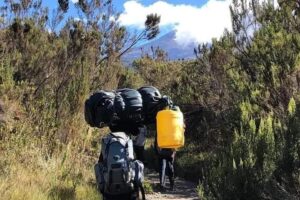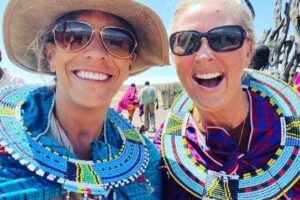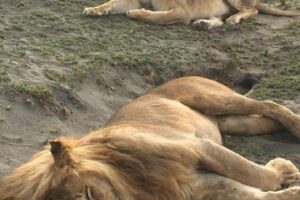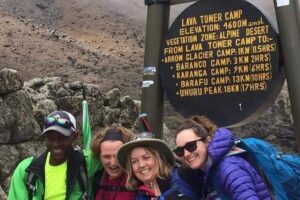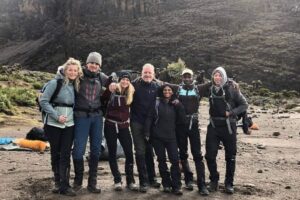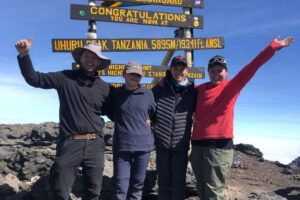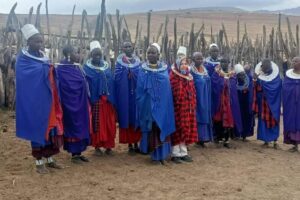Adventure of a Lifetime Kilimanjaro Climb and a 5 Day Safari
Kilimanjaro sits at the base of the great Riff Valley, standing at 19,341 feet in elevation, making it the tallest free standing mountain in the world. Summit name is Uhuru Point.
Kilimanjaro was most likely formed by volcanic eruptions building layers of molten rock upon themselves. Kilimanjaro is 205 miles south of the Equator in Tanzania, Africa. At the time in distant history Kilimanjaro had triple cones of volcanic activity. Which were Kibo at an elevation of 19,340 feet, Mawenzi at an elevation of 16,893 feet, and Shira at 13,000 feet in elevation. At this point in time Shira is no longer a peak, but a plateau on Kilimanjaro’s west side. When Shira was active it elevation was believed reach 16,000 feet in elevation.
Kilimanjaro at this point in its history is a dormant volcano, that hasn’t erupted in 10,000 years and its last major eruption be 360,00 years ago.
The first documented assent of Kilimanjaro was 1889 by Hans Meyer a German Geologist, accompanied by Ludwigh Purtscheller an Austrian climber and Yohani Kinyala Lauwo local guide.
Hans support team consisted of a cook, nine porters, and two local tribal leaders.
Kilimanjaro Climb and Five Day Safari Itinerary
7 Days / 6 nights – Kilimanjaro climb
Climb up Kilimanjaro is a Moderate Hike
Day 1:
Arrive in Tanzania and be picked up at the Kilimanjaro International Airport and transferred to your hotel in Moshi town. Where you will meet your guide.
You be will brief you on your upcoming trek and do an equipment check to make sure you have all the necessary mountain gear. The missing gear can be
rented on this day. Meals: No Meals Included for this day.
Climb up Kilimanjaro is a Moderate Hike
Day 1:
Arrive in Tanzania and be picked up at the Kilimanjaro International Airport and transferred to your hotel in Moshi town. Where you will meet your guide.
You be will brief you on your upcoming trek and do an equipment check to make sure you have all the necessary mountain gear. The missing gear can be
rented on this day. Meals: No Meals Included for this day.
Your accommodations are at http://www.salinerohotels.com
Day 2:
Day at Leisure. Spend it stretching and getting ready for your trek up Kilimanjaro and taking in the local sights. Overnight at your hotel.
Day at Leisure. Spend it stretching and getting ready for your trek up Kilimanjaro and taking in the local sights. Overnight at your hotel.
Day 3:
You will start your Trek up Kilimanjaro at Machame Gate (1790m) to Machame Camp (3010m)
It is a Two hour’s and half drive from Arusha to Machame gate, where we complete park formalities, meet our crew of porters and start to climb!
The first section of the trail climbs steadily and passes through magnificent, dense rainforest. This path is less traveled so it can get somewhat overgrown
You will start your Trek up Kilimanjaro at Machame Gate (1790m) to Machame Camp (3010m)
It is a Two hour’s and half drive from Arusha to Machame gate, where we complete park formalities, meet our crew of porters and start to climb!
The first section of the trail climbs steadily and passes through magnificent, dense rainforest. This path is less traveled so it can get somewhat overgrown
in places and it is often wet and muddy underfoot.
Distance you will hike: 10.8km / 6.7mi Approx. time taken: 6 hours
Distance you will hike: 10.8km / 6.7mi Approx. time taken: 6 hours
Day 4:
You leave Machame Camp (3010m) to Shira Camp (3845m) Our route continues on up through the forest until we reach the steep ascent onto the Shira Plateau,
where there are incredible panoramic views of the mountain. Looking back, you will be able to see Mt Meru rising high above Arusha town in the distance.
Distance of today’s hike is: 5.4km / 3.4mi it will take Approx. time taken: 5 hours
Day 5:
Breaking camp at Shira Cave (3845m) you hike to Barranco Camp (3960m) You are now on high moorland, the landscape topography changes to an African Alpine
Distance of today’s hike is: 5.4km / 3.4mi it will take Approx. time taken: 5 hours
Day 5:
Breaking camp at Shira Cave (3845m) you hike to Barranco Camp (3960m) You are now on high moorland, the landscape topography changes to an African Alpine
on the portion of the trek. You are now traversing the southwest side of Kilimanjaro, passing beneath the Lava Tower and the final section of the Western Breach
and finally reach camp The day has been spent at altitude (up to 4600m), we’ll have followed the mountaineering code of “hiking high altitude”, “sleep
at low altitude” to aid your body’s acclimatization to altitude. The distance covered is: 10.8km / 6.7mi, in Approx. time taken: 8 hrs.
Day 6:
You will leave Barranco Camp (3960m) to Karanga Camp (3963m), And your day starts by descending into the Great Barranco, a huge ravine. We then exit steeply,
and finally reach camp The day has been spent at altitude (up to 4600m), we’ll have followed the mountaineering code of “hiking high altitude”, “sleep
at low altitude” to aid your body’s acclimatization to altitude. The distance covered is: 10.8km / 6.7mi, in Approx. time taken: 8 hrs.
Day 6:
You will leave Barranco Camp (3960m) to Karanga Camp (3963m), And your day starts by descending into the Great Barranco, a huge ravine. We then exit steeply,
up the Great Barranco Wall, that divides you from the southeastern slopes of Kibo. You will climb over a massive rock, that’s not a technical climb, but long and tiring. Passing underneath the Heim
and Kersten glaciers, we head towards the Karanga valley. From here we have a steep climb up from Karanga valley to our night’s camp at Karanga camp,
and Kersten glaciers, we head towards the Karanga valley. From here we have a steep climb up from Karanga valley to our night’s camp at Karanga camp,
set at 3963m. For those feeling strong, you will have the opportunity for a mid-afternoon hike up to around 4200m before hiking back to camp for the night.
Distance of hike is: 5.5km / 3.4mi, taking Approximately 5 hours.
Day 7:
You leave Karanga Camp (3963) in the morning and hike to Barafu Camp (4640m), a distance of 3km / 1.9 miles which will take approximately 3 hours. The hike to Barafu Camp will take us across desolate scree slopes devoid of vegetation around us at all. It’s a tough steep hike to the summit made more difficult due to the altitude.
Distance of hike is: 5.5km / 3.4mi, taking Approximately 5 hours.
Day 7:
You leave Karanga Camp (3963) in the morning and hike to Barafu Camp (4640m), a distance of 3km / 1.9 miles which will take approximately 3 hours. The hike to Barafu Camp will take us across desolate scree slopes devoid of vegetation around us at all. It’s a tough steep hike to the summit made more difficult due to the altitude.
It is important to keep hydrated and warm. Barafu is your basecamp where you get a good night’s rest and eating for the rest of afternoon as you prepare for a long night and day ahead. It is important to keep hydrated and warm. You will have an early dinner and get some sleep as we will be getting up at between 11pm and 12pm to prepare for the climb to the summit of Kilimanjaro.
Day 8:
You will leave Barafu Camp (4640m) around mid-night and hike to to UHURU PEAK (5895m) on Kilimanjaro and down to Millennium Camp (3790m). Today’s hike will cover a distance
of 13.4km / 8.3 miles taking approximately 12 to 15 hours.
The hike is very steep up to the summit and local glaciers. You will be hiking through the topography of scree for 4 to 5 hours gaining incredible elevation
over a short distance. The views are spectacular. You ought to be on the crater rim at Stella Point (5739m) as the first rays of the sunrise hit you. Spectacular ice cliffs within the crater
surround you and the views of the jagged Mawenzi peak and beyond are breathtaking. Another hour’s hike takes you to the summit, Uhuru Peak (5895m), where you begin your
descent by returning to Stella Point and then descending on the scree slope and back back to Barafu Camp for breakfast, before finally heading down to Millennium Camp
descent by returning to Stella Point and then descending on the scree slope and back back to Barafu Camp for breakfast, before finally heading down to Millennium Camp
for a long well-earned rest.
Day 9:
Hike from Millennium Camp (3790m) to Mweka Gate (1630m) is a gentle trek takes us down through the rain forest to Mweka Gate a distance of 12.1km / 7. miles which will take approximately 6 hours, where we complete park formalities
Day 9:
Hike from Millennium Camp (3790m) to Mweka Gate (1630m) is a gentle trek takes us down through the rain forest to Mweka Gate a distance of 12.1km / 7. miles which will take approximately 6 hours, where we complete park formalities
and receive certificates, which you can hang up with pride! Then are met by our vehicles and return to the hotel in Moshi (http://www.salinerohotels.com) where you can treat yourself to a welcome hot shower.
Day 10:
Tarngire National Park Safari
After Breakfast you head off to Arusha – Tarngire National Park – Karatu for Safari.
This morning you take a packed lunch with you and for a three hour drive to Tarangire National Park spending the afternoon exploring on safari for wildlife as you are driven
through the park. The Park is separated by the Tarangire River which cut through it providing a gathering place for all manner of wildlife during the long dry season when the
surrounding area becomes completely parched. During the wet season the wildlife are more scattered but you are still almost guaranteed sightings of Tarangire’s extensive elephant population.
This morning you take a packed lunch with you and for a three hour drive to Tarangire National Park spending the afternoon exploring on safari for wildlife as you are driven
through the park. The Park is separated by the Tarangire River which cut through it providing a gathering place for all manner of wildlife during the long dry season when the
surrounding area becomes completely parched. During the wet season the wildlife are more scattered but you are still almost guaranteed sightings of Tarangire’s extensive elephant population.
Large herds roam the riverbed while zebra, buffalo, gazelle and wildebeest try to avoid the predatory advances of lion and leopard. There is also a remarkable
profuse populations of birds life in the Tarangire swamps. There are 550 species of birds, including many rare species. Late afternoon proceed to Karatu.
You enjoy dinner and spend the night at Eileen’s Trees Inn ( http://www.eileenstrees.com/ )
Day 11:
You enjoy dinner and spend the night at Eileen’s Trees Inn ( http://www.eileenstrees.com/ )
Day 11:
Serengeti National Park Safari
After breakfast drive to Serengeti National park. The Serengeti National Park is the jewel in the crown of Tanzania’s game parks and offers arguably the best game viewing in Africa.The setting is perfect a sea of endless plains that stretches across the horizon as far as the eye can see, dotted with the occasional acacia tree and termite mound.
This savannah is home to huge large herds of buffalo that make a mass migration every year North, through crocodile infested rivers, in a frenzied mixture of mating and migration
that is driven by instinct. Prides of lion rule here, their hungry gaze sweeping the savannah for a chance to attack the thousands of eland, impala and gazelle.
that is driven by instinct. Prides of lion rule here, their hungry gaze sweeping the savannah for a chance to attack the thousands of eland, impala and gazelle.
As solitary leopard stake out their place in the high branches of the acacia tree and herds of elephants roam at will. The Serengeti is the Africa so entrenched in our minds by the countless
documentaries you have watch. At the close of the day dinner and a night spent Thorn Tree Camp ( https://thorntreecamp.com/ )
Day 12:
On Day 12 you spend the whole day in Serengeti National park on a wildlife safari photographing and enjoy the wildlife in their natural habitat.
At the end of the day you return to Thorn Tree Camp for dinner and a night of rest and sleep.
Day 12:
On Day 12 you spend the whole day in Serengeti National park on a wildlife safari photographing and enjoy the wildlife in their natural habitat.
At the end of the day you return to Thorn Tree Camp for dinner and a night of rest and sleep.
Day 13:
On this day in get an start early with packed lunches, drive to Ngorongoro Crater and descend 2000feet to the Crater floor for game viewing. You will have a chance
to explore the Ngorongoro Crater, an ancient volcanic crater that is home to an extraordinary concentration of wildlife including a very dense population of lions
and spotted hyena. You are almost guaranteed to see all of the ‘big five’ (lion, rhino, leopard, elephant and buffalo) of African Wildlife Species, plus a great variety of other species;
The views are superb, from the first glimpse of the crater at ‘Heroes’ Point’, through the thick rain forest that covers its sides, down to the rich grassy plains
that form its center. The combination of natural scenery and wildlife is truly breath-taking experience. During the game drive you will stop for a delicious picnic on the crater floor.
that form its center. The combination of natural scenery and wildlife is truly breath-taking experience. During the game drive you will stop for a delicious picnic on the crater floor.
Late in the afternoon drive to Eileen’s Trees Inn Lodge for dinner and spend the night..
Day 14:
beautiful, the calm waters stretching for nearly 50km along the base of the Rift Valley escarpment, flecked with the pink of a thousand flamingos.
Day 14:
Lake Manyara National Park Safari
After you have eaten breakfast you drive to Lake Manyara National park with packed lunches for a day of game viewing. Lake Manyara National park, a real scenic gem. The lake itself isbeautiful, the calm waters stretching for nearly 50km along the base of the Rift Valley escarpment, flecked with the pink of a thousand flamingos.
Here is dense jungle-like forest that is home to groups of baboons and the thick acacia forest is where you can spy the tree-climbing lions for which the park is so famous.
You will enjoy game viewing for several hours before driving back to Moshi for dinner and spend the night at the Sal Salinero Hotel.
Day 15:
You will rise and be taken from your hotel to Kilimanjaro International Airport for your flight home, or you may make other arrangements and stay to explore more of Africa
All The Included Inclusions for Kilimanjaro Climb and Five Day Safari
- Return transfers from the airport
- 4 nights at a hotel in Moshi – two nights before and 1 after the climb and 1 after safari
- Tents (Tents Sleep 2 if you desire to sleep alone cost is $80)
- and after safari on Bed and breakfast
- Accommodation during the climb, transfers from the hotel to National
- Park gate and back
- Climbing fees (Park Fees)
- Porters (3 per person) and guide/s
- Cook
- All meals
- Climbing fees
- Rescue fees
- Mess tent table and chairs
- Oxygen
- Purse oximeter
- First Aid Kit
- Chemical toilet
- Accommodation while on safari in the hotels and lodges as mentioned on
- the safari itinerary including last in Moshi after safari on FB
- All sightseeing and excursions as mentioned in the itinerary
- Park Entrance and Crater service fee
- Transport in a 4×4 custom made safari vehicle with an English-speaking
- driver guide.
- Meals as outlined in the itinerary
- All lodging is double occupancy, if you desire a singe room a $150. extra per lodging night.
All The Extra’s Not Include in Expedition
- Climbing gear
- Sleeping bags
- Items of personal nature
- Laundry
- Tips and gratuities in Reality Plan on at least 25% cost of the Expedition
- Mineral water
- Drinks & travel insurance
- Airfare
- Meals not mentioned in the itinerary
- Early or late check in at hotels
Cost of Kilimanjaro Climb and 5 Day Safari is $5400. USD
Non refundable Deposit of $1500 is Required.
Trips maybe split to do just the Kilimanjaro Climb cost of $3400 USD
Five Day Safari cost of $3200 USD
